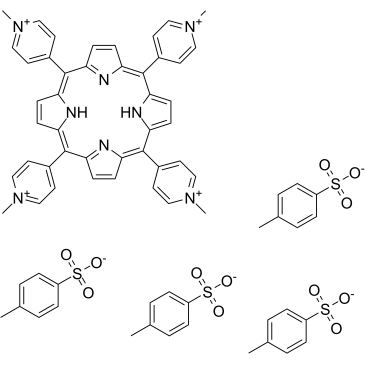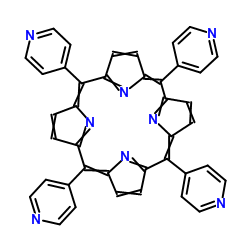5,10,15,20-Tetrakis(N-methyl-4-pyridyl)porphine tetratosylate

5,10,15,20-Tetrakis(N-methyl-4-pyridyl)porphine tetratosylate structure
|
Common Name | 5,10,15,20-Tetrakis(N-methyl-4-pyridyl)porphine tetratosylate | ||
|---|---|---|---|---|
| CAS Number | 36951-72-1 | Molecular Weight | 1363.60 | |
| Density | N/A | Boiling Point | N/A | |
| Molecular Formula | C72H66N8O12S4 | Melting Point | N/A | |
| MSDS | Chinese USA | Flash Point | N/A | |
| Symbol |

GHS07 |
Signal Word | Warning | |
Use of 5,10,15,20-Tetrakis(N-methyl-4-pyridyl)porphine tetratosylateTMPyP4 tosylate (TMP 1363) is a quadruplex-specific ligand, which inhibits the interaction between G-quadruplexes and IGF-1[1]. TMPyP4 tosylate (TMP 1363) is a telomerase inhibitor with antitumor effects in osteosarcoma cell lines[2]. |
| Name | meso-tetrakis(N-methyl-4-pyridyl)porphine tetrakis(p-toluenesulfonate) |
|---|---|
| Synonym | More Synonyms |
| Description | TMPyP4 tosylate (TMP 1363) is a quadruplex-specific ligand, which inhibits the interaction between G-quadruplexes and IGF-1[1]. TMPyP4 tosylate (TMP 1363) is a telomerase inhibitor with antitumor effects in osteosarcoma cell lines[2]. |
|---|---|
| Related Catalog | |
| Target |
G-quadruplex[2] Telomerase[2] |
| References |
| Molecular Formula | C72H66N8O12S4 |
|---|---|
| Molecular Weight | 1363.60 |
| Exact Mass | 1362.368286 |
| PSA | 334.14000 |
| LogP | 10.08380 |
| Storage condition | 2-8°C |
| Water Solubility | water: soluble50MM(lit.) |
|
Section I.Chemical Product and Company Identification Chemical NameTMPyP [=Tetrakis(1-Methylpyridinium-4-yl)porphine p-Toluenesulfonate] [Ultra-high sensitive spectrophotometric reagent for Cu, Mg, and use for the simultaneous determination of metals by HPLC.] Portland OR SynonymNot available.
C72H66N8O12S4 Chemical Formula CAS Number36951-72-1 Section II.Composition and Information on Ingredients Chemical NameCAS Number Percent (%)TLV/PELToxicology Data TMPyP [=Tetrakis(1-Methylpyridinium-4-yl)porphine36951-72-1-------------- Not available.Not available. p-Toluenesulfonate] [Ultra-high sensitive spectrophotometric reagent for Cu, Mg, and use for the simultaneous determination of metals by HPLC.] Section III. Hazards Identification Acute Health EffectsIrritating to eyes and skin on contact. Inhalation causes irritation of the lungs and respiratory system. Inflammation of the eye is characterized by redness, watering, and itching. Skin inflammation is characterized by itching, scaling, reddening, or, occasionally, blistering. Follow safe industrial hygiene practices and always wear proper protective equipment when handling this compound. Chronic Health EffectsCARCINOGENIC EFFECTS : Not available. MUTAGENIC EFFECTS : Not available. TERATOGENIC EFFECTS : Not available. DEVELOPMENTAL TOXICITY: Not available. There is no known effect from chronic exposure to this product. Repeated or prolonged exposure to this compound is not known to aggravate existing medical conditions. Section IV.First Aid Measures Eye ContactCheck for and remove any contact lenses. DO NOT use an eye ointment. Flush eyes with running water for a minimum of 15 minutes, occasionally lifting the upper and lower eyelids. Seek medical attention. Treat symptomatically and supportively. Skin ContactAfter contact with skin, wash immediately with plenty of water. Gently and thoroughly wash the contaminated skin with running water and non-abrasive soap. Be particularly careful to clean folds, crevices, creases and groin. Cover the irritated skin with an emollient. Seek medical attention. Treat symptomatically and supportively. Wash any contaminated clothing before reusing. InhalationIf the victim is not breathing, perform artificial respiration. Loosen tight clothing such as a collar, tie, belt or waistband. If breathing is difficult, oxygen can be administered. Seek medical attention. Treat symptomatically and supportively. IngestionINDUCE VOMITING by sticking finger in throat. Lower the head so that the vomit will not reenter the mouth and throat. Loosen tight clothing such as a collar, tie, belt, or waistband. If the victim is not breathing, administer artificial respiration. Examine the lips and mouth to ascertain whether the tissues are damaged, a possible indication that the toxic material was ingested; the absence of such signs, however, is not conclusive. Seek immediate medical attention and, if possible, show the chemical label. Treat symptomatically and supportively. Section V.Fire and Explosion Data Not available. Combustible.Auto-Ignition Flammability Flammable Limits Flash PointsNot available. Not available. Combustion ProductsThese products are toxic carbon oxides (CO, CO 2), nitrogen oxides (NO, NO2), sulfur oxides (SO2, SO3...). Fire Hazards No specific information is available regarding the flammability of this compound in the presence of various materials. Continued on Next Page a5oppTMPyP [=Tetrakis(1-Methylpyridinium-4-yl)porphine p-Toluenesulfonate] [Ultra-high sensitive spectrophotometric reagent for Cu, Mg, and use for the simultaneous determination of metals by HPLC.] Explosion HazardsRisks of explosion of the product in presence of mechanical impact: Not available. Risks of explosion of the product in presence of static discharge: Not available. No additional information is available regarding the risks of explosion. Fire Fighting Media SMALL FIRE: Use DRY chemicals, CO 2, water spray or foam. and InstructionsLARGE FIRE: Use water spray, fog or foam. DO NOT use water jet. Section VI.Accidental Release Measures Spill CleanupIrritating material. InstructionsIn case of a spill and/or a leak, always shut off any sources of ignition, ventilate the area, and exercise caution. Use a shovel to put the material into a convenient waste disposal container. Finish cleaning the spill by rinsing any contaminated surfaces with copious amounts of water. Consult federal, state, and/or local authorities for assistance on disposal. Section VII. Handling and Storage IRRITANT. HYGROSCOPIC. Keep away from heat and sources of ignition. Mechanical exhaust required. When not in Handling and Storage use, tightly seal the container and store in a dry, cool place. Avoid excessive heat and light. DO NOT ingest. DO NOT Information breathe dust. In case of insufficient ventilation, wear suitable respiratory equipment. If ingested, seek medical advice immediately and show the container or the label. Treat symptomatically and supportively. Avoid contact with skin and eyes. Always store away from incompatible compounds such as oxidizing agents, moisture. Section VIII. Exposure Controls/Personal Protection Engineering ControlsUse process enclosures, local exhaust ventilation, or other engineering controls to keep airborne levels below recommended exposure limits. If user operations generate dust, fume or mist, use ventilation to keep exposure to airborne contaminants below the exposure limit. Splash goggles. Lab coat. Dust respirator. Boots. Gloves. A MSHA/NIOSH approved respirator must be used to avoid Personal Protection inhalation of the product. Suggested protective clothing might not be sufficient; consult a specialist BEFORE handling this product. Exposure Limits Not available. Section IX. Physical and Chemical Properties Physical state @ 20°CPurple powder.Solubility Not available. Not available. Specific Gravity Molecular WeightPartition Coefficient 1363.63Not available. Boiling PointVapor Pressure Not available.Not available. Melting PointNot available.Vapor DensityNot available. Refractive IndexNot available.VolatilityNot available. Critical TemperatureNot available.OdorNot available. ViscosityNot available.TasteNot available. Section X.Stability and Reactivity Data Stability This material is stable if stored under proper conditions. (See Section VII for instructions) Conditions of InstabilityHygroscopic; keep container tightly closed. Avoid excessive heat and light. Incompatibilities Reactive with oxidizing agents, moisture. Section XI. Toxicological Information RTECS NumberNot available. Eye contact. Inhalation. Ingestion. Skin contact. Routes of Exposure Toxicity DataNot available. CARCINOGENIC EFFECTS : Not available. Chronic Toxic Effects MUTAGENIC EFFECTS : Not available. TERATOGENIC EFFECTS : Not available. DEVELOPMENTAL TOXICITY: Not available. There is no known effect from chronic exposure to this product. Repeated or prolonged exposure to this compound is not known to aggravate existing medical conditions. Continued on Next Page TMPyP [=Tetrakis(1-Methylpyridinium-4-yl)porphine p-Toluenesulfonate] [Ultra-high sensitive spectrophotometric reagent for Cu, Mg, and use for the simultaneous determination of metals by HPLC.] Acute Toxic EffectsIrritating to eyes and skin on contact. Inhalation causes irritation of the lungs and respiratory system. Inflammation of the eye is characterized by redness, watering, and itching. Skin inflammation is characterized by itching, scaling, reddening, or, occasionally, blistering. Follow safe industrial hygiene practices and always wear proper protective equipment when handling this compound. Section XII.Ecological Information EcotoxicityNot available. Environmental FateNot available. Section XIII. Disposal Considerations Waste DisposalRecycle to process, if possible. Consult your local or regional authorities. You may be able to dissolve or mix material with a combustible solvent and burn in a chemical incinerator equipped with an afterburner and scrubber system. Observe all federal, state, and local regulations when disposing of this substance. Section XIV. Transport Information DOT Classification Not a DOT controlled material (United States). PIN NumberNot applicable. Proper Shipping NameNot applicable. Packing Group (PG)Not applicable. DOT Pictograms Section XV. Other Regulatory Information and Pictograms TSCA Chemical InventoryThis product is NOT on the EPA Toxic Substances Control Act (TSCA) inventory. The following notices are required by 40 CFR 720.36 (C) for those products not on the inventory list: (EPA) (i) These products are supplied solely for use in research and development by or under the supervision of a technically qualified individual as defined in 40 CFR 720.0 et sec. (ii) The health risks of these products have not been fully determined. Any information that is or becomes available will be supplied on an MSDS sheet. WHMIS Classification WHMIS CLASS D-2A: Material causing other toxic effects (VERY TOXIC). (Canada) EINECS Number (EEC) Not available. EEC Risk StatementsR36/37/38- Irritating to eyes, respiratory system and skin. SECTION 16 - ADDITIONAL INFORMATION N/A |
| Symbol |

GHS07 |
|---|---|
| Signal Word | Warning |
| Hazard Statements | H315-H319-H335 |
| Precautionary Statements | P261-P305 + P351 + P338 |
| Personal Protective Equipment | dust mask type N95 (US);Eyeshields;Gloves |
| Hazard Codes | Xi: Irritant; |
| Risk Phrases | R36/37/38 |
| Safety Phrases | 26-36/37 |
| RIDADR | NONH for all modes of transport |
| WGK Germany | 3 |
|
~36% 
5,10,15,20-Tetr... CAS#:36951-72-1 |
| Literature: Bonnet, Raymond; Ridge, R. J.; Land, Edward J.; Sinclair, Roy S.; Tait, David; Truscott, T. George Journal of the Chemical Society, Faraday Transactions 1: Physical Chemistry in Condensed Phases, 1982 , vol. 78, p. 127 - 136 |
|
Platinum nanoparticles on porphyrin functionalized graphene nanosheets as a superior catalyst for methanol electrooxidation.
Nanoscale 6(24) , 14999-15007, (2014) A novel nanostructured catalyst of platinum nanoparticles supported on 5,10,15,20-tetrakis(1-methyl-4-pyridinio)porphyrin tetra(p-toluenesulfonate) (TMPyP) functionalized graphene (TMPyP-graphene) is ... |
|
|
"Turn-off-on" fluorescent sensor for (N-methyl-4-pyridyl) porphyrin -DNA and G-quadruplex interactions based on ZnCdSe quantum dots.
Anal. Chim. Acta 888 , 131-7, (2015) As a new detection model, the reversible fluorescence "turn-off-on" sensor based on quantum dots (QDs) has already been successfully employed in the detections of many biochemical materials, especiall... |
|
|
The singlet-oxygen-sensitized delayed fluorescence in mammalian cells: a time-resolved microscopy approach.
Photochem. Photobiol. Sci. 14(4) , 700-13, (2015) The present work provides a proof-of-concept that the singlet oxygen-sensitized delayed fluorescence (SOSDF) can be detected from individual living mammalian cells in a time-resolved microscopy experi... |
| 4,4',4'',4'''-(5,10,15,20-Porphyrintetrayl)tetrakis(1-methylpyridinium) tetrakis(4-methylbenzenesulfonate) |
| TMPyP4 tosylate |
| 4-methylbenzenesulfonate,5,10,15,20-tetrakis(1-methylpyridin-1-ium-4-yl)-21,22-dihydroporphyrin |
| 4,4',4'',4'''-Porphyrin-5,10,15,20-tetrayltetrakis(1-methylpyridinium) tetrakis(4-methylbenzenesulfonate) |
| 5,10,15,20-Tetrakis(N-methyl-4-pyridyl)porphine tetratosylate |
| MFCD00013468 |
| TMPyP ,Mg] [Fo |
| α,β,γ,δ-Tetrakis(1-methylpyridinium-4-yl)porphyrin p-Toluenesulfonate |
| TMPYP |
| tmpyp tetratosylate |

